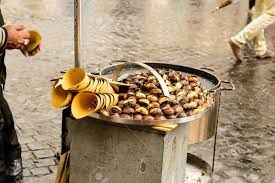Chestnuts roasting on an open fire……yes ‘tis the season for chestnuts.
The roasted nuts seem humble compared to the finer fares offered by today’s mobile vendors, but their history is as rich as their distinct aroma.
I get nostalgic around the holidays. Holidays bring back memories of simpler times, harder time, yes, but happy times, too. Now that I am starting to see chestnuts for sale in the local stores it brings back wonderful memories of younger days and living in NYC. When I walked to Central Park with my Dad on a Sunday. As we got closer to 5th Avenue the smell of chestnuts roasting was wafting around everywhere. I would opt to give up a box of Cracker Jacks, with its tantalizing prize, so that we could buy a bag while walking home. And there was nothing like holding that warm bag of delicious chestnuts in my November cold hands.
But those day are gone now as is the lonely chestnut vendor.
Roasted chestnuts seem humble compared to the finer fares offered by today’s mobile vendors, but their history is as rich as their distinct aroma.

The chestnut vendor in those days was a member of NYC’s “pushcart army” of some 25,000 immigrants who kept Gotham sated with snacks from their stands. In winter, roasted chestnuts were a pushcart standby, their toasty shells doubling as handwarmers while the vendor stood steadfast in the cold trying to make a meager living.
Everyone knows Gotham is in the grips of a gourmet street food craze. But while culinary cognoscenti follow taco trucks on Twitter, they might not realize that one of the most pedigreed sidewalk snacks is right under the nose this time of year: roasted chestnuts.
The hardy chestnut contains a starchy flesh associated with winter since well before there were sidewalks on which to peddle them. For centuries, the towering chestnut was the most ubiquitous tree in eastern North America, accounting for 25 percent of all hardwoods. It was said that a squirrel could walk the length of the Appalachians, from Georgia to Maine, touching only chestnut branches.
The Northeast was known for its spectacular chestnut harvests, a mainstay for bird, beast and man. Its starchy flesh was a staple of the Lenape diet, eaten like potatoes or beans, and pounded into flour for cakes and bread. The Iroquois enjoyed a beverage made from chestnuts that was similar to coffee, and Colonial settlers also relied on the chestnut for sustenance during the long, cold winters. Specific associations with the holidays can be traced to 16th-century France and Italy, where desserts like marrons glaces and cake made from chestnut flour remain traditional parts of holiday meals.
American chestnuts so prized for being sweeter and richer than their European cousins. The introduction of Asian Chestnuts in 1905 brought a blight that wiped out all 4 billion American Chestnut trees.
A few lone specimens still stand around the country—and a handful of blight-resistant crosses were recently planted on Governor’s Island by the American Chestnut Foundation, the National Park Service and the Department of the Interior. In winter, the aroma of roasting chestnuts on city streets is still familiar, but, these days, like so many things associated with Christmas, they’re imported.
INGREDIENTS
- 1 ½ cups chestnut flour
- 1/3 cup sugar
- 1 tb baking powdeR
- 2 tb cocoa powder – more for dusting
- 2 tbs honey
- pinch of salt
- ½ extra virgin olive oil
- 2 large eggs – room temperature
- 1 cup whole milk
- ½ cup drige cranberries
- 1/3 cup walnuts – toasted, chopped
- ½ cup rasins
- 1/3 cup pine nuts – toasted
- vin santo – for plumping raisins
METHOD
- Preheat oven to 350º.
- Lightly brush a 9-inch cake pan with olive oil.
- Put the raisins and dried cranberries into a ¼ cup of Vin Santo to plump them up.
- Sift together flour, sugar, baking powder, cocoa powder and salt in a large bowl.
- In a separate bowl, whisk together olive oil, honey eggs and milk.
- Slowly pour the liquids into the dry ingredients, whisking very well and making sure there are no lumps. The batter should be smooth but a bit liquidy.
- Reserve some of the fruits and nuts to sprinkle on top of the cake.
- Add the remaining to the batter and mix well to make sure all is combined and spread evenly
- Pour the batter into the prepared pan, sprinkle the reserved fruits/nuts on top and bake for about 25 minutes, or until the cake begins to swell lightly and the middle is set.
- Remove from the oven and cool completely before removing from the pan.
- When ready to serve dust lightly with powdered sugar and cocoa powder. When serving, sprinkle some warmed honey on each slice.
Buon Mangiata!

